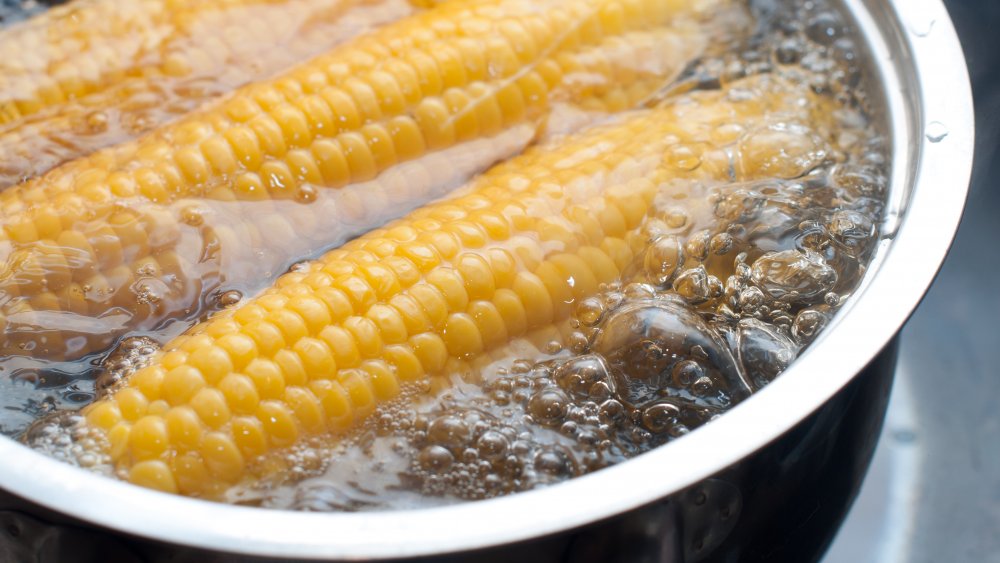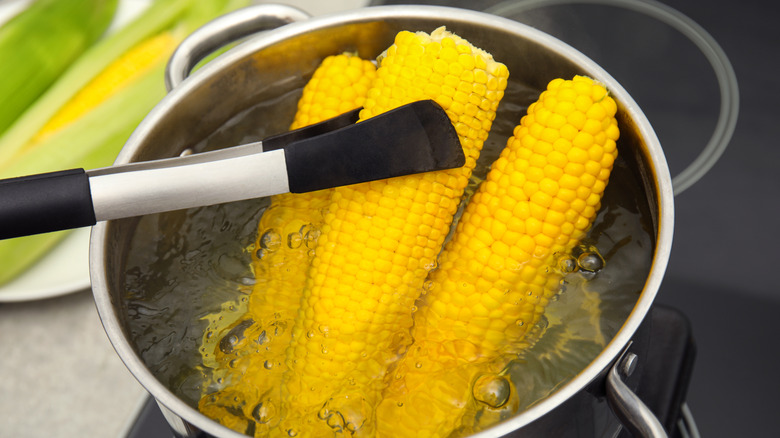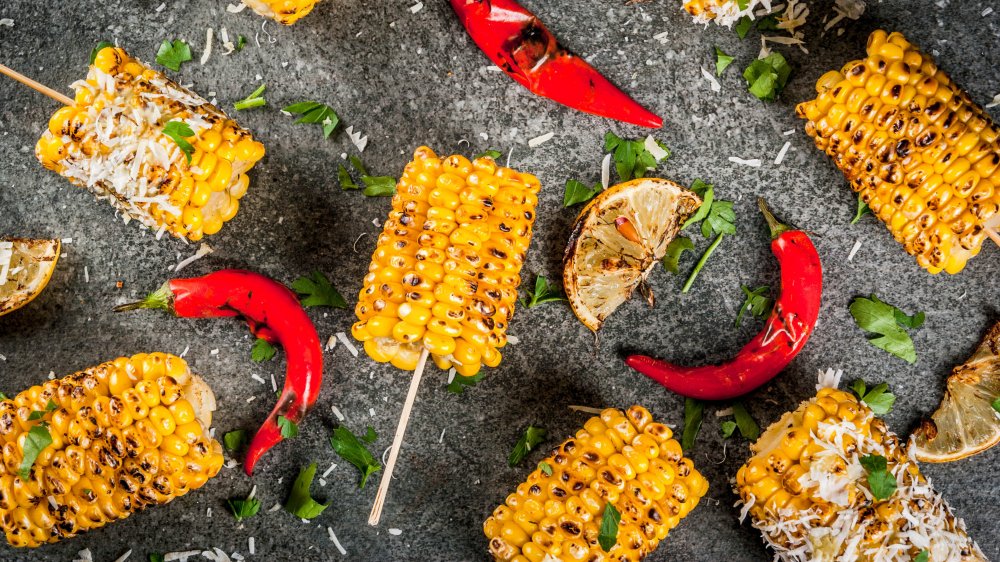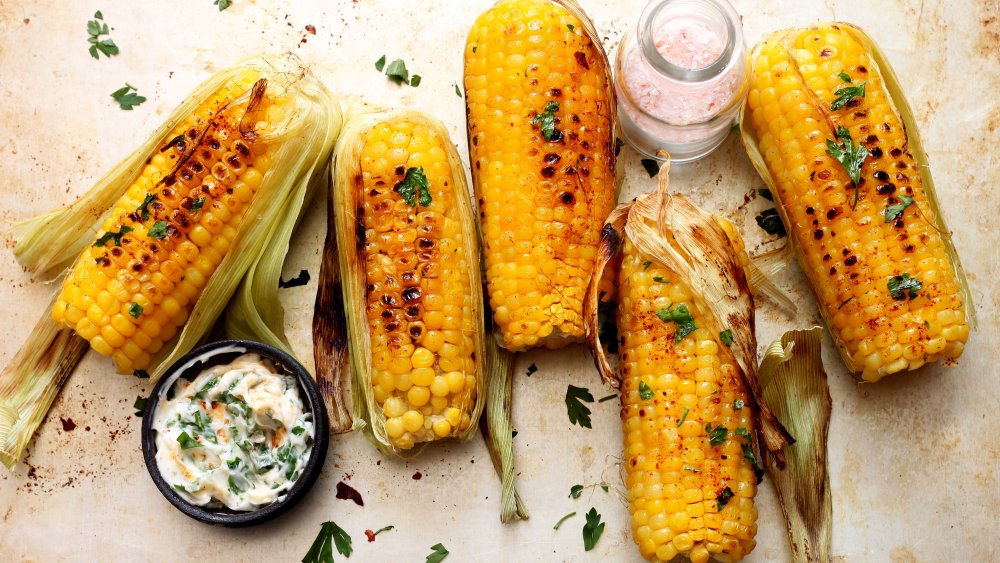The Real Reason You Shouldn't Boil Corn On The Cob
There are countless ways to prepare corn on the cob: it can be boiled, grilled, oven-roasted, or even thrown into the microwave. Of course, you can also boil corn on the cob.
Sticking corn into a pot of hot water is a pretty standard and uncomplicated way to do things, right? Plus, it allows you to focus less on the corn and more on how you'll season and serve it. Just boil some water in a pot, toss in the corn, stir occasionally, and keep an eye on a timer. Why not make cooking the sides for your next family get-together or summer barbecue that much easier? After all, it tastes fine, especially with some butter and salt added to it afterwards.
Well, there's a good reason to keep those ears out of boiling water and instead opt for another method of cooking. And it has to do with nutrition.
Corn loses nutrients when it's boiled
Corn, an ancient multipurpose food, contains folate, or folic acid — also known as vitamin B9. Folic acid allows the body to healthily produce red and white blood cells, and it also helps with the conversion of carbohydrates into energy — in other words, it promotes a healthy metabolism. A cup of corn contains about 19 percent — just under a fifth — of the daily value you should consume of the vitamin (via Healthline). It's particularly important in pregnancies, as it lowers the possibility of birth defects (via WebMD).
When corn is boiled, it loses some of its folic acid and other nutrients, which seep into the water instead of serving as helpful vitamins (via Allrecipes). You're essentially making your corn less healthy by dropping it into that pot. We suggest steaming corn: it takes even less time than boiling, it keeps those nutrients locked into the ears, and if you're really short on time, you can literally do it by popping the ears, husks still intact, into the microwave (via Huffington Post). It's almost like making popcorn minus the guilt.
Other cooking methods are better for corn
Not only does steaming corn in the husk allow the nutrients to stay put rather than disappearing into the water you'll end up dumping down the drain, according to dietitian Kelly Jones, but the ease of doing it allows you to use corn on the cob to its full potential. Steaming a vegetable isn't necessarily more complicated than boiling: Fill a pot with water, and place a steamer basket above the water. Once the water is boiling, the steaming process should take somewhere between four and six minutes, making it the quickest way to cook corn on the cob (via Taste of Home). It's important to allow the corn to cool. Once you can safely touch the husks, they peel quickly and easily.
With such a short cooking time, steaming corn allows you more time to brainstorm ways to make your corn on the cob creatively delicious. There's nothing wrong with a barebones tray of corn on the cob with a little salt and butter. But while you're here, we'll throw out a few ideas to spice up your side dish, so hopefully, you're all ears: Wrap it in prosciutto, or sprinkle some sesame seeds (via Fine Cooking). Why not drizzle on some honey and butter or a little sriracha (via Seattle Times)? Or garlic and parmesan? See how many ideas you can explore while you're not taking the time to awkwardly drain a pot of hot water? Your taste buds are the limit.
The corn-cooking possibilities are endless
Besides saving time and nutrients, steaming your corn can allow you to cook several foods at once: Sam Sifton, the editor at NYTimes Cooking, throws corn into a pot with bacon, clams, and white wine, producing a soupy, flavorful dish that stops you from boiling water and wasting nutrients. Once you've entered the beautiful world of steamed corn, you'll soon realize you've got even more options.
Grilling corn in its husk allows for a sweet, smoky, complex flavor. Placing the ears directly on the grill will produce a lovely char and, in about 10 minutes, ears full of tender corn (via Delish). But watch out: It's important to trim the ends of the husk, so nothing catches on fire at your barbecue (via The Kitchn). You can also slather the ears with butter and oven-roast them in foil, though this takes closer to 30 minutes. Steaming corn in a crockpot or a rice cooker? Yes, it's possible (via Better Homes & Gardens). The crockpot method will take you two to four hours, but it takes minimal effort and the taste might be worth the wait.
Hot tip: Once you've steamed your corn (grilled, roasted, etc.), you can actually continue enjoying its lovely sweetness once the kernels are long gone. By saving the corn cobs and boiling them with water, you can make a corn stock for soups, stews, and polentas, as Sean Sherman does — a nod to the chef's Indigenous Lakota roots (via CBS News).



